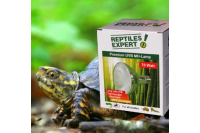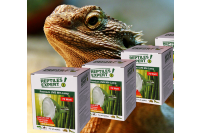We use cookies to make your experience better. To comply with the new e-Privacy directive, we need to ask for your consent to set the cookies. Learn more.
Why do reptiles need UVB radiation?
The relationship between UVB radiation and vitamin D3 synthesis and types of ultraviolet (UV) radiation
As cold-blooded animals, reptiles need the sun to increase their body temperature. This increase in temperature causes more activity - the animals can move faster and have the energy to eat, hunt and also digest. Many reptiles therefore go to a sunbathing spot and the natural sun provides the heat for this. But in addition, the important vitamin D3 synthesis takes place in the uppermost layers of the skin due to the UVB radiation. Vitamin D3 is very important for bone formation and prevents diseases such as rickets (softening of the bones) or shell softening in turtles. Not only heat is necessary for this process, but also UVB radiation. In the process, vitamin D3 is produced via some preliminary and intermediate products.
This happens automatically in the great outdoors due to the sun. By the way, also in mammals and thus also in humans. Of course there are differences, depending on the climate zones in which the reptiles are found. Adapted to different habitats - from hot desert areas and steppes to tropical rainforest areas to Mediterranean zones or our temperate latitudes. The solar radiation is different everywhere and the animals are adapted to their respective biotopes. It is not only the heat output of the sun that varies depending on the latitude, but also the UV radiation.
You have to differentiate between the different UV rays. UVB radiation is important for vitamin D3 synthesis. 90% of UVB is filtered out by the atmosphere. Thus, only about 10% of this special UVB radiation reaches the earth's surface. However, when the sun is at an angle (early in the morning or late in the afternoon during the day or in the colder seasons of autumn and winter) or when the sun's angle of incidence is flatter (in Central Europe compared to Mediterranean or tropical latitudes), even less UVB occurs the surface of the earth. This is because the sun's rays travel a longer distance diagonally through the atmosphere - the "filter" is therefore wider, the UVB radiation is lower. Other UV rays - such as UVA are also important - but for purposes other than vitamin D3 synthesis. The UVA portion is also higher than the UVB portion because the atmosphere filters out less of this longer-wave radiation. The dangerous short-wave UVC radiation does not reach the earth's surface at all - it is 100% filtered.
In summary, one can say that reptiles need the following UV radiation:
UVB radiation for vitamin D3 synthesis (calcium metabolism, bone formation, prevention of deficiency symptoms such as rickets)
UVA radiation for general wellbeing and visual visibility (reptiles can also see UVA light).
In the terrarium, the natural sun must be replaced by artificial light sources. There are special UVB lamps for terrariums for this. These lamps not only produce very bright visible light, but also the important UV radiation (UVB for vitamin D3 synthesis & UVA) and the necessary heat. Modern UVB metal halide lamps have the advantage of combining all of these 3 factors: UV light, visible light and heat. Reptiles from desert or rain forest areas need these UV lamps particularly urgently, since the natural solar radiation is too low in our temperate latitudes, even in summer. In the Mediterranean area, too, the sun's rays are much higher than here in Central Europe.
Which UVB lamp is right for the animal depends on many different factors. There are different technologies for all requirements. You can find more information on this in my blogs and in our Reptiles Expert Matrix.
You are also welcome to contact us directly if you have any questions.





